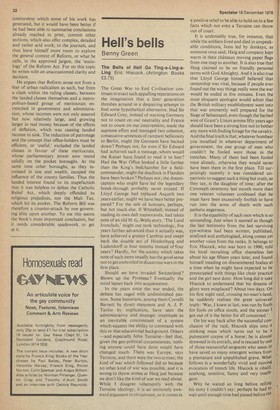The Party's over?
John Kenyon
The Growth of Parliamentary Parties 1689-1742 B. W. Hill (Allen and Unwin E7.95) The Politics of Deference: A Study of the Mid-Nineteenth-Century English Political System David Cresap Moore (Harvester E15.50) I suppose the study of early political parties in England is more relevant to the understanding of our modern condition than most historical research, and it is a pity that the picture presented is still so confused and contradictory. In the days of Whiggish, preNamierite innocence it used to be assumed that the Whig and Tory parties had their origin in the Exclusion Crisis, under Charles II, or perhaps even in the Great Rebellion against Charles I. They then proceeded in linear progression, though sometimes a trifle uncertainly and erratically, down to the mid-nineteenth century, when the Whigs swelled into the Liberals, then burst under the strain, leaving the new Labour Party to take their place in a two-party structure.
The late Sir Lewis Namier destroyed this picture, no doubt unwittingly, in 1929, when he demonstrated that in the 1760s parties identifiable as such had scarcely existed at all. Other scholars then extended this unfortunate `blank spot' back to 1742, at least, and forward a little, to 1792. But the repercussions were unnecessarily severe. This is because many historians were so used to anthropomorphising political institutions that they could not conceive of parties existing, say, in 1714 and 1810 but not in 1760—any more than they could envisage King George II being alive and well in 1742 and 1756, but dead in 1746. They would have done well to heed what Richard Pares said of the premiership, because it applies equally well to parties: The development of this institution, as of all others which are affected by personal ascendencies or deficiencies in this quarter or in that, must not be thought of as continuous—as when we perceive, in the heart of a fog, a whitish blob which curdles into a tram and advances along the line, growing larger and more distinct, until it stops obediently at our feet. It is more like that of the Cheshire Cat : sometimes there is almost a whole cat, sometimes no more than a grin, and it is not always the same end that appears first. But if parties could be said not to have existed in the mid-eighteenth century, some historians could not rest until they had erased their previous history, well-establish ed as it was. The result was Robert Wal Namierian methods, that in the period 1689 to 1714 party was a mere fiction, and that politics was based instead on all small kinship, friendship or patronage groups arranged along a Court v. Country axis, not Whig v. Tory at all.
It was a theory which conflicted with most of the evidence available, except that selected for presentation by Walcott, and it was promptly denounced by those working in the field. Unfortunately, the more perversely revisionist a theory is the more modish it appears, and Walcott made many conquests amongst writers of textbooks, even those so eminent as Sir Ivor Jennings. So the orthodoxy of a fleeting moment still survives in odd corners of academe. However, Walcott's theory did have the salutary effect of focusing on the early eighteenth century the outraged attention of an unusual number of able scholars and, as is often the case, their rejection of his revision swung the pendulum back far beyond the vertical. We now have historians like W. A. Speck asserting the two-party theory of English history in a much stricter and more dogmatic form than even G. M. Trevelyan essayed.
The trouble is, much of this research is
still locked away in the obscurity of learned journals, and though important general statements have been made, by Geoffrey Holmes, for instance, and J. H. Plumb, they only cover limited sections or aspects of the whole. There is thus room for a scholarly synthesis covering a broader period, and Brian Hill, who has published important work of his own in this field, is well equipped to provide it. The picture he gives, while it bears the stamp of his own personality, would he accepted by most historians: that the Revolution of 1688 threw the tiny
Whig and Tory groups surviving from Charles ll's reign into ideological confusion, and that suspicion of
William III, and the intensification of government power
during a major war
enhanced the vigour of the backbench `Country' element. But the need to impose some sort of order on the House of Commons, the aggravation of disputes over the Church, the Revolution and the conduct of the War of the Spanish Succession, led to a distinct polarisation into two major parties,
which by the end of Anne's reign monopolised the Commons between them and had achieved, at least on the Whig side, a precocious degree
of organisation and discipline. Moreover, he argues, contrary to the accepted view,
that these party divisions continued as an important factor in Hanoverian politics at least down to 1742, and despite the fact that in the next generation or two party divisions did become of less importance, the tradition remained (as did the names), and it could be taken up again in the next reign.
So, in the eighteenth century we are being re-educated into believing in parties; in the nineteenth we have now to be persuaded to disbelieve in them. It is a remarkable feature of Professor Moore's new book that he never mentions anything recognisable as a historical ideology of Whiggism or Toryism.
Yet if there was any period which used to offer us a firm footing it was the 1830s, when the Whigs under Earl Grey, after years in the wilderness, took advantage of a Tory split over Catholic emancipation to crash through the first Reform Act, which gave them the alliance of the urban Radicals. Instead David Moore would have us believe that this was a deliberate attempt to strengthen the landed interest, and not just by buying radical support (which is no new idea), but by increasing the representation of rural areas and stemming the invasion of the county constituencies by carpet-baggers from the towns. In other words, the Radical interest was certainly to be strengthened, but the landed classes were to be strengthened much more, and the two were to be rigorously separated. In support he offers a detailed analysis of voting patterns in three counties before and after the Reform Act, a detailed scrutiny of the different recensions of the two Bills which were successively put before Parliament, and a survey of the working of the Act up to 1867.
It had better be said that this is not an easy book; its revelations are more obscure than revelations ought to be, and it will not surrender some of its jealously-guarded secrets at all to people (like reviewers) who can only find time to read it once. This is partly a matter of technique; Moore's prose is thick and phlegmy, his arguments ponderous and repetitive—and the very fact that he repeats many of his points in successive paraphrases reflects an understandable unease. True, some of the blame rests with his material and the questions he is seeking to answer.
All the same, there is much which I suspect could have been better explained. For instance, he stresses that it is more important in this period to find out whom men voted with, not whom they voted for. This leads to talk of electoral 'blocs' and (more mysteriously) 'congeries' and 'circles' of influence, which are not explained; indeed, they seem to be taken for granted. Nor is it clear what all this has to do with the title of the book; in fact, 'deference' is scarcely mentioned after the first chapter, and it is not clear whether this is natural, unforced deference, or coercive deference, based on the landlord-tenant relationship.
Moreover, much of all this has been explained (or not explained) by Moore in a number of celebrated articles in learned journals, which have generated vigorous discussion. Moore does not disguise the controversy which some of his work has generated, but it would have been better if he had been able to summarise conclusions already reached in print, commit other sections, which also offer complex, detailed and rather arid work, to the journals, and thus leave himself more room to explore the general context of Reform, or what he calls, in the approved jargon, the 'sociology' of the Reform Act. For on this topic he writes with an unaccustomed clarity and decision.
He argues that Reform arose not from a fear of urban radicalism as such, but from a clash within the ruling classes; between the landed classes themselves and a metropolitan-based group of meritocrats entrenched in government and administration, whose incomes were not only assured but now relatively large, and growing larger in real money because of the effects of deflation, which was causing landed income to sink. The reduction of patronage and the concept that office-holders must be efficient, or 'useful,' excluded the landed classes in favour of these meritocrats, whose parliamentary power now rested solidly on the pocket boroughs. At the same time other boroughs, as they increased in size and wealth, escaped the influence of the county families. Thus the landed interest found to its stupefaction that it was helpless to defeat the Catholic Relief Act, which deeply offended its religious prejudices, nor the Malt Tax, which hit its pocket. The Reform Bill was therefore a counter-attack by one governing elite upon another. To me this seems the book's most important conclusion, but it needs considerable spadework to get at it.















































 Previous page
Previous page